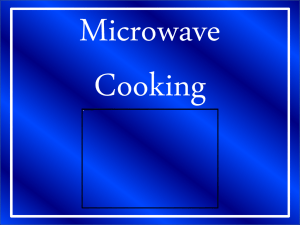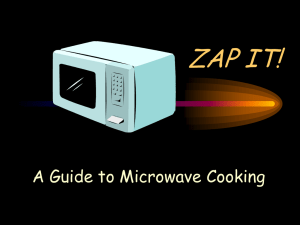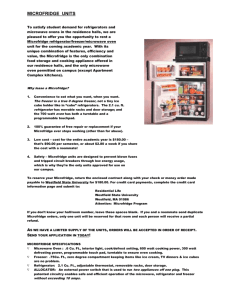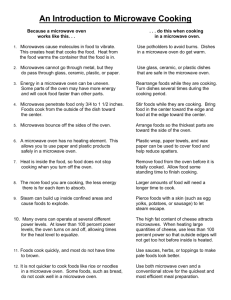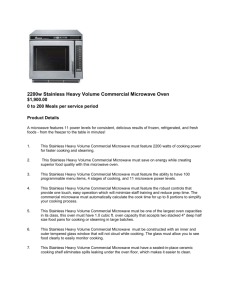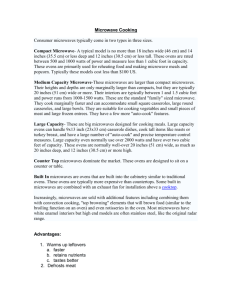Microwave Cooking Worksheet: Safety & Recipe Adaptation
advertisement
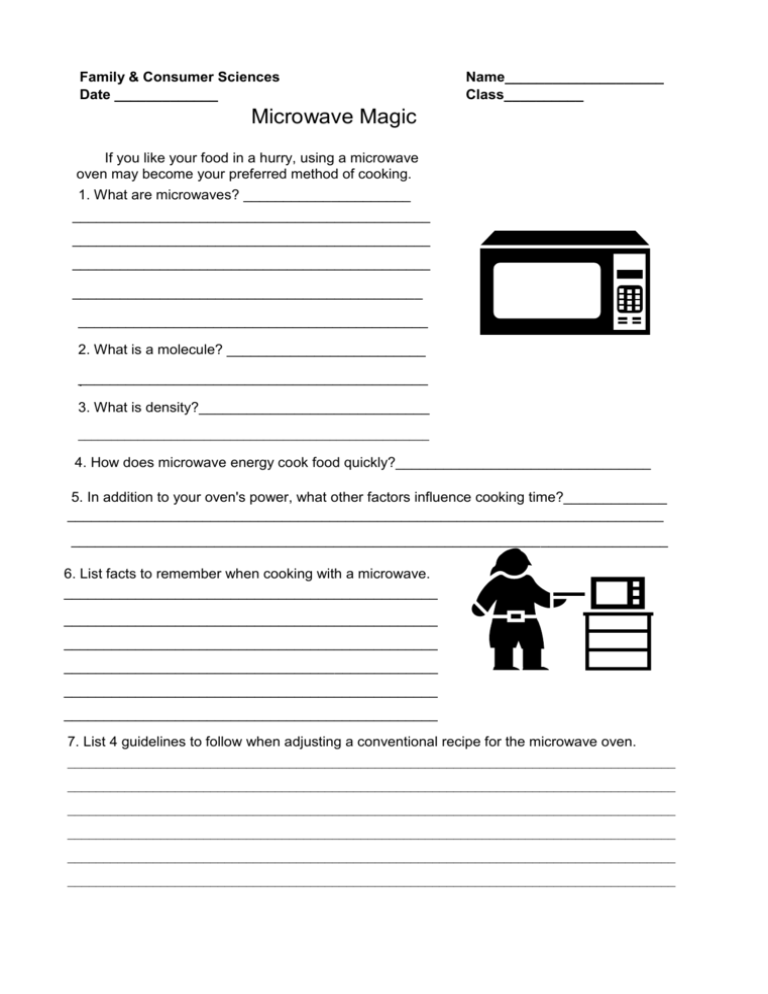
Family & Consumer Sciences Date _____________ Name____________________ Class__________ Microwave Magic If you like your food in a hurry, using a microwave oven may become your preferred method of cooking. 1. What are microwaves? _____________________ _____________________________________________ _____________________________________________ _____________________________________________ ____________________________________________ ____________________________________________ 2. What is a molecule? _________________________ ____________________________________________ . 3. What is density?_____________________________ _____________________________________________________ 4. How does microwave energy cook food quickly?________________________________ 5. In addition to your oven's power, what other factors influence cooking time?_____________ ___________________________________________________________________________ ___________________________________________________________________________ 6. List facts to remember when cooking with a microwave. _______________________________________________ _______________________________________________ _______________________________________________ _______________________________________________ _______________________________________________ _______________________________________________ 7. List 4 guidelines to follow when adjusting a conventional recipe for the microwave oven. _____________________________________________________________________________________ _____________________________________________________________________________________ _____________________________________________________________________________________ _____________________________________________________________________________________ _____________________________________________________________________________________ _____________________________________________________________________________________ BACKGROUND INFORMATION Microwaves are a form of electromagnetic energy much like that of heat, light, or radio waves. A magnatron tube within the oven produces the microwaves and a fan distributes them throughout the oven. The waves penetrate the food and cause the molecules (the smallest portion of an element or compound that retains its chemical identity) of the food to vibrate rapidly, thus creating heat by friction. This acts in the same way as rubbing your hands together to cause heat. Simply, a microwave oven is a device that produces electromagnetic energy that is converted into heat by vibrating water fat and sugar molecules. The cooking time in a microwave oven is determined by starting temperature, the volume of food, the density, the moisture content, and the shape of the food. Density refers to lightness, firmness, or porous nature of the substance. Microwaves penetrate dense substances more slowly; therefore, cooking time needs to be increased. Likewise, foods with high water content require more energy to reach the desired temperature. Foods with a relatively high fat or sugar content come to temperature quickly in a microwave oven. For example, the frosting on a cupcake will become hot before the cupcake itself; meat closest to the fat will heat first, and so on. The shape of the food influences the cooking time. Flat, thin food articles heat faster than thick, large pieces. Try to keep pieces of food the same size for even heating. When possible, arranging food into a round shape avoids overcooking on the edges. Stirring will help to redistribute the heat within some foods. Another technique is turning the food or repositioning it to allow even cooking. Covering the food helps to retain steam and to speed cooking. Microwaves cook from the outside in and only penetrate into the food 1 to 1½ inches. These techniques are helpful for cooking larger quantities. Food will continue to cook when it is removed from the microwave oven. It is necessary to allow up to two minutes of standing time when cooking. This is especially true for large pieces of dense foods. Some important facts about microwave cooking to remember are the following: 1. Pierce whole fruits or vegetables before cooking to allow steam to escape. 2. Do not cook eggs in the shell. Pierce the yolk with the tip of a fork before cooking. 3. Pierce or open plastic lids or other airtight containers to allow steam to escape. 4. Thick liquids should be stirred before and during heating to avoid eruption. 5. If foods begin to smoke or burn, turn off oven and extinguish the fire. 6. Do not use containers with restricted openings, such as baby food jars or catsup bottles because of rapid expansion. 7. Do not use metal cookware because sparks (arcing) will occur. 8. Do not use newspapers and recycled paper in a microwave oven because they can burn. 9. Don’t reheat Chinese food in containers with metal handles. 10. Don’t use mugs, glasses or serving ware with metallic rims or decoration. To adapt your favorite recipe for use in the microwave oven, study the recipe. Is it a food that microwaves well? Look for cooking techniques that are similar to microwave techniques, such as covering, steaming, or cooking in sauce or liquid. If the food requires a crisp crust or very dry surface, it may be better to cook it conventionally. Since liquids do not evaporate when microwaved, reduce the amount in saucy casseroles. Add more thickening to sauces and gravies. Reduce some seasonings; they will not lose intensity in the short time required for microwave cooking. Salt meat and vegetables after cooking. If an ingredient takes longer to microwave than others in the same dish, precook that ingredient before adding it to the dish.
